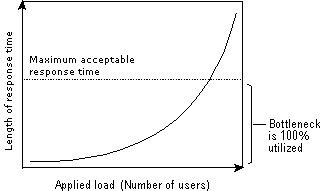
A system bottleneck is the service center with the highest demand in your organization. Demand is the number of visits to a service center multiplied by the average time each visit takes. For example, if a workload is causing 100 disk accesses per second and the disk accesses takes 1 millisecond, then the demand for the disk is 100 milliseconds per second, or 10 percent. Keep the following concepts in mind when analyzing bottlenecks:
The illustration below shows a characteristic response-time curve that all multiuser servers share. As the load on the server increases, usage of the bottleneck resource comes closer to saturation (100 percent utilization) more of the time. As it does so, queuing in front of the resource increases, which causes response times to slow down. As the resource nears 100 percent utilization, the response time slows rapidly.
A server that hosts satisfied users is not operating with its resources very close to saturation. There is "elbow room" for the bottleneck resource, and the system operates in the part of the response rate curve that is below the acceptable response time limit. When the system is operating above that line, it's time to relieve the bottleneck.
